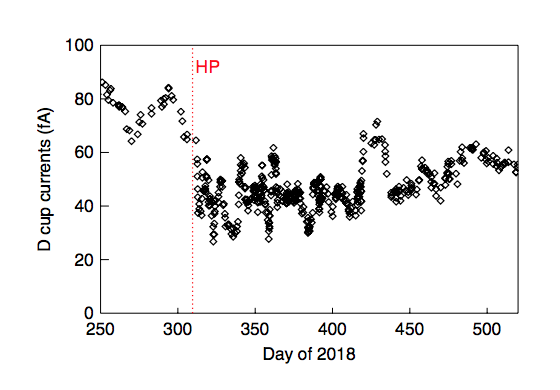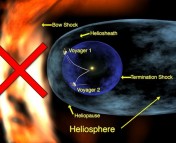Title: Voyager 2 plasma observations of the heliopause and interstellar medium
Authors: John D. Richardson, John W. Belcher, Paula Garcia-Galindo, Leonard F. Burlaga
First Author’s Institution: Kavli Institute for Astrophysics and Space Research; Massachusetts Institute of Technology
Status: Published in Nature Astronomy [closed access]
Where does the solar system actually end? We could say it’s where the Sun’s gravity stops being strong enough to hold onto things. This would make it the edge of the Oort Cloud, the loosely bound sphere of rocky and icy bits left over from the solar system’s formation, extending almost 3 light-years from the Sun. Or, we could say it’s where the energetic particles from the Sun (the solar wind) stop flowing away from us, blocked by the pressure of all the other gas that’s between stars, the interstellar medium
Today, we’ll focus on the latter: the heliopause, the boundary where the solar wind meets the interstellar medium (ISM), which marks the edge of the heliosphere, the bubble of gas surrounding the Sun. Both the solar wind and the ISM are made of plasma, the 4th state of matter. In a plasma, some of the electrons have been stripped off the atoms, leaving charged particles (ions) to move around. There are a few different parts of the heliosphere, and the Voyager missions, launched in the 1970s, have traveled through all of them.
After traveling far beyond the planets, the two Voyager missions first encountered a region where the solar wind slows down below the speed of sound, known as a termination shock. Their next big milestone would be the heliopause (see Figure 1 for illustration). This is an important and unique part of our solar system to understand; it is where our solar system and our star interact with the surrounding galaxy. There’s a lot we can learn here about how forces and magnetic fields in the plasma of the interstellar medium confine and influence the solar wind. The heliopause is even important for understanding how life comes about in solar systems – it’s what protects us from dangerous cosmic rays and other high energy radiation that could be disastrous for life.

Voyager 1 crossed the heliopause first in 2012, at 121.7 Astronomical Units, (AU) meaning Voyager 1 was 121.7 times further from the Sun than the Earth is. Voyager 2 finally reached this milestone in late 2018, at 119 AU, passing through a slightly different flow of the solar wind than Voyager 1 did, as shown in Figure 2. Although Voyager 1 gave us the first information on the heliopause, it passed through a weird spot, where the solar wind seemed to be flowing more slowly and in ways we wouldn’t expect. It also didn’t get to take all its measurements, since its plasma instrument was broken. Since 2012, astronomers have been waiting for Voyager 2 to reach this milestone, so that they can take new measurements and understand another perspective of the heliopause, including the speed and direction of the plasma’s flow, its temperature, and its density in that region.

So, what did Voyager 2 see out there? As it approached the heliopause, it entered a “boundary layer” – a region where the density and magnetic field increase as the solar wind encounters the ISM. Voyager 1 also traveled through this layer, and observed something unusual: the flow of the solar wind was stagnated, traveling much more slowly than expected. Voyager 2 saw very different velocities of the solar wind near the boundary, and although we’re not sure why these two observations were so different, the authors think they might be due to instabilities in the boundary layer; the heliosphere isn’t a perfect bubble, instead its edges might have swirls and uneven patches. It took the spacecraft 8 days to cross this boundary region, but the actual heliopause is so sharply defined that it only took 1 day to cross (as shown in Figure 3)!

After the heliopause, Voyager 2 was officially out in the “very local interstellar medium” (VLISM). The VLISM isn’t perfectly smooth either; Voyager 2 observed variations in the speed, flow direction, density, and temperature of the plasma out there, and found that the further it gets from the heliopause, the more dense the VLISM gets. This makes sense, since it’s cooler out there (around 7500 K, a bit hotter than the Sun’s surface) than it is closer to the heliopause, where gas gets compressed as the solar wind presses into the ISM, and the plasma is observed to be much hotter – around 30,000 K! This is actually hotter than expected, suggesting that the plasma is getting more compressed or heated in other ways. Voyager 2 also passed through an interesting region where the current in the plasma spiked up (illustrated in the data in Figure 4); the authors think this is a shock, a sudden change in pressure and density.

Having direct measurements of all this plasma and matter beyond the heliopause is important, because it’s literally the stuff that is between ALL the stars! Most of the universe (besides dark matter, of course) is made of plasma, and after more than 30 years of traveling and waiting, now we have the chance to directly observe it.
Originally created as a mission to study Jupiter and Saturn up close, the Voyager probes ended up flying by Jupiter, Saturn, Uranus, Neptune, and 48 of their moons. Now, they’re continuing past the planets, past the heliopause, and into interstellar space. Both Voyagers are now out there observing the VLISM – and we can look forward to getting info on all this stuff between stars as long as the spacecraft stay alive and communicating with Earth.




Loved the article, super interesting. Just one bone to pick: the heliopause is important for protecting life on earth, but it says nothing about how life could come about. Looking forward to future articles like this. Thanks.